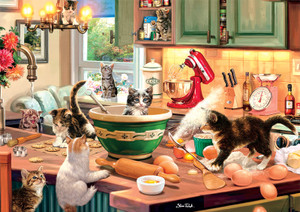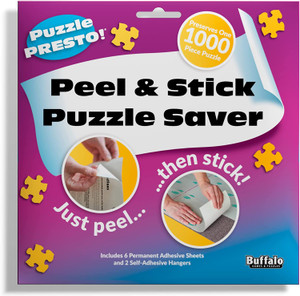Posted by Buffalo Games on Aug 2nd 2022
3 Fun Facts About Puzzles
First of all, we have to confess something: jigsaw puzzles aren’t made with jigsaws. Score one for the fastidious.
But score one for semantics, too, because it’s not like people didn’t know that commercial puzzles these days are cut by huge dies that allow for millions of puzzles a year to be manufactured.
Heck, you can even get puzzle subscriptions these days, which is awesome, but it also means they’re not going to be turned out by hand. With that understood, here are 3 fun facts about puzzles:
1. Some Jigsaw Puzzles Are Still Created by Hand
Did you know that the original jigsaw puzzles were, in fact, cut with jigsaws? Hence the name. That’s probably belaboring the obvious, but we’re going to stick with it because history is cool.
Most people are quite familiar with today’s commercial cardboard jigsaw puzzles. They probably even think that’s all there ever has been — that a cardboard jigsaw puzzle jumped fully formed from the mind of its inventor.
But the fact is that it’s been a generational team effort. Many minds have come together to produce the jigsaw puzzles of today, and there have been many historical forces — most of them economic — at play too. We’ll get there in a moment.
Given that it’s the topic of this section, we’ll focus on the first iterations of the puzzle-making art. Curiously enough, as things often do, the first versions are making a comeback and being dubbed “artisanal,” which makes puzzles sound a bit like a crusty loaf of bread.
But it’s a burden to have to cut your bread with a jigsaw, even if it is artisanal, and besides, handmade jigsaw puzzles are made from plywood, not flour.
The plywood itself is formed from sheets of thinly sliced wood that are milled by spinning a log against a very long and sharp blade, peeling it into veneers. These veneers are then cut into rough sheets that measure just over eight feet by four feet and kiln dried to a specific moisture.
Each sheet is a ply, which is where plywood gets its name, and these plies are glued together under pressure in layers with a hot mixture of resin (tree sap) and wheat flour, believe it or not.
That gives us our tie-in to artisanal bread, and this next bit gives us our tie-in to the jigsaw: quite often these days, puzzles that are made from plywood aren’t jigsaw puzzles for adults — they’re intended for children.
Probably the most compelling cause for this demographic focus is the fact that it’s quite difficult to make superfine cuts with a jigsaw; therefore, the pieces have to be a little larger with smaller tabs and blanks, if any.
The truly artisanal jigsaw puzzles these days aren’t cheap because of this difficulty. In fact, many of them abandon the jigsaw altogether in favor of either a CNC (Computer Numerical Control) waterjet or laser.
These applied technologies are bringing costs down, but there are still many plywood puzzles out there that are priced at $5,000 and above. That’s an expensive hobby. It makes us want to forget it and just go bake a loaf of bread.
2. Puzzle Makers Are Crafty
We don’t just mean to make a punny joke with that heading. Really — some manufacturers are throwing wicked curve balls at their customers.
One such puzzle maker (which shall remain nameless) actually dared to release a puzzle some years back that had no possible solution. That is, it was not possible to solve the thing because they intentionally included gaps with no pieces and pieces that didn’t fit. On purpose. Yikes. The puzzlers didn’t appreciate that play, needless to say.
Another trick — this one quite a bit less infuriating — is the practice of color line cutting. This is a technique that leverages the image on the puzzle. These jigsaw puzzle pieces are cut along the lines in the image, not just into random standard-shaped puzzle pieces. This approach makes for a very difficult puzzle to solve.
But the last trick is just about as dirty as the day is long. It’s called the phony corner, and it goes like this: Let’s say you’re solving a puzzle in the shape of a rectangle. You’ve sorted your pieces into groups only to discover that you have more than four corners in your collection of puzzle pieces.
Maybe you have five, or maybe you have fifteen. Now you have to figure out where those extra ones go. Where? Certainly not in any one of the four corners that are true.
3. Jigsaw Puzzles Have Been Around for More than 250 Years
The first jigsaw puzzles were made by a man who wanted to teach geography to young children in a new, exciting, hands-on way. He called them dissected maps, but we would recognize them today as plywood jigsaw puzzles.
It became a thing, but only for the rich. In the beginning of the trend toward manufacturing and selling jigsaw puzzles, taking one home from the puzzles store would cost you a week’s wages if you were a peasant, so jigsaw puzzles were the exclusive purview of the aristocracy.
That held true until the Great Depression when a technological advancement from the late 1800s finally came into its own. That advancement was the idea of printing images onto cheap cardboard sheets and using dies to cut them into jigsaw puzzles.
In the beginning, people heaped scorn on this mass-produced product. By the end of 1929, however, when people could no longer afford to purchase scorn in heaps (nor indeed to use it that way), the modern version of the jigsaw puzzle was born.
Societal enthusiasm for the jigsaw puzzle has risen and fallen over the years with the tides of economic boon. Some wags predicted puzzles’ certain death with the rise of the video game and the internet, but COVID soon proved them wrong.
The popularity of the humble jigsaw puzzle is soaring in the wake of lockdown protocols, and with that popularity comes the hope that most people will put down their screens in favor of a little fun with jigsaw puzzles for adults. It just goes to show you that you never can tell what may come about as history’s twists and turns unravel before us.
Batteries are not included — because you don’t need them. And in our book, that’s pretty awesome.


















































